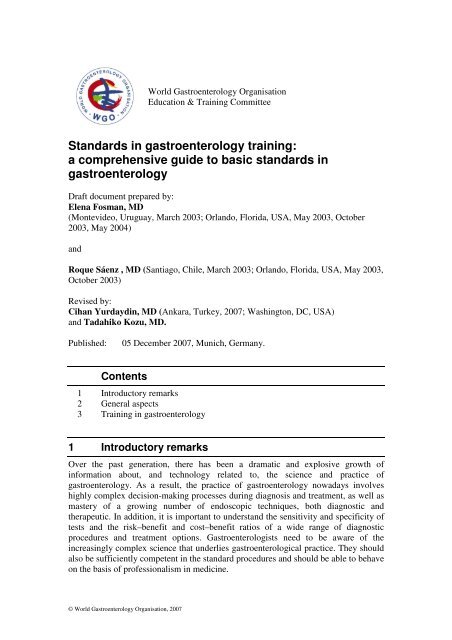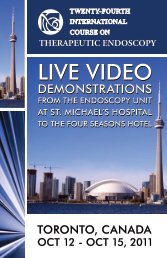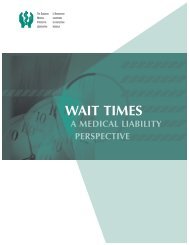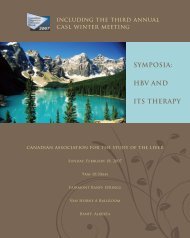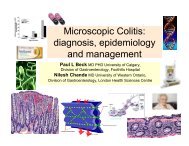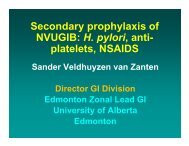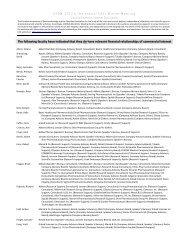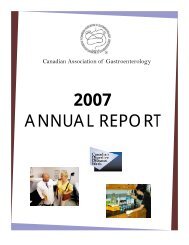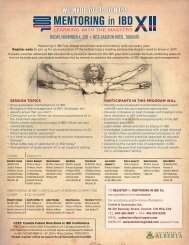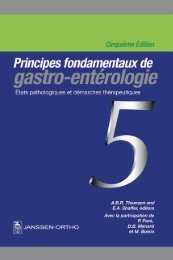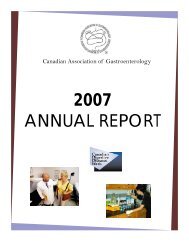a comprehensive guide to basic standards in gastroenterology
a comprehensive guide to basic standards in gastroenterology
a comprehensive guide to basic standards in gastroenterology
You also want an ePaper? Increase the reach of your titles
YUMPU automatically turns print PDFs into web optimized ePapers that Google loves.
World Gastroenterology Organisation<br />
Education & Tra<strong>in</strong><strong>in</strong>g Committee<br />
Standards <strong>in</strong> <strong>gastroenterology</strong> tra<strong>in</strong><strong>in</strong>g:<br />
a <strong>comprehensive</strong> <strong>guide</strong> <strong>to</strong> <strong>basic</strong> <strong>standards</strong> <strong>in</strong><br />
<strong>gastroenterology</strong><br />
Draft document prepared by:<br />
Elena Fosman, MD<br />
(Montevideo, Uruguay, March 2003; Orlando, Florida, USA, May 2003, Oc<strong>to</strong>ber<br />
2003, May 2004)<br />
and<br />
Roque Sáenz , MD (Santiago, Chile, March 2003; Orlando, Florida, USA, May 2003,<br />
Oc<strong>to</strong>ber 2003)<br />
Revised by:<br />
Cihan Yurdayd<strong>in</strong>, MD (Ankara, Turkey, 2007; Wash<strong>in</strong>g<strong>to</strong>n, DC, USA)<br />
and Tadahiko Kozu, MD.<br />
Published:<br />
05 December 2007, Munich, Germany.<br />
Contents<br />
1 Introduc<strong>to</strong>ry remarks<br />
2 General aspects<br />
3 Tra<strong>in</strong><strong>in</strong>g <strong>in</strong> <strong>gastroenterology</strong><br />
1 Introduc<strong>to</strong>ry remarks<br />
Over the past generation, there has been a dramatic and explosive growth of<br />
<strong>in</strong>formation about, and technology related <strong>to</strong>, the science and practice of<br />
<strong>gastroenterology</strong>. As a result, the practice of <strong>gastroenterology</strong> nowadays <strong>in</strong>volves<br />
highly complex decision-mak<strong>in</strong>g processes dur<strong>in</strong>g diagnosis and treatment, as well as<br />
mastery of a grow<strong>in</strong>g number of endoscopic techniques, both diagnostic and<br />
therapeutic. In addition, it is important <strong>to</strong> understand the sensitivity and specificity of<br />
tests and the risk–benefit and cost–benefit ratios of a wide range of diagnostic<br />
procedures and treatment options. Gastroenterologists need <strong>to</strong> be aware of the<br />
<strong>in</strong>creas<strong>in</strong>gly complex science that underlies gastroenterological practice. They should<br />
also be sufficiently competent <strong>in</strong> the standard procedures and should be able <strong>to</strong> behave<br />
on the basis of professionalism <strong>in</strong> medic<strong>in</strong>e.<br />
© World Gastroenterology Organisation, 2007
WGO Standards <strong>in</strong> <strong>gastroenterology</strong> tra<strong>in</strong><strong>in</strong>g 2<br />
At a meet<strong>in</strong>g held <strong>in</strong> Orlando, Florida, <strong>in</strong> May 1999, the WGO Education<br />
Committee (chaired by Dr. James Toouli) set up a subcommittee—the Committee for<br />
Standards <strong>in</strong> Gastroenterology Tra<strong>in</strong><strong>in</strong>g—<strong>in</strong> order <strong>to</strong> work <strong>to</strong>wards establish<strong>in</strong>g global<br />
<strong>standards</strong> for provid<strong>in</strong>g education and tra<strong>in</strong><strong>in</strong>g <strong>in</strong> <strong>gastroenterology</strong> and for practic<strong>in</strong>g<br />
the specialty. The project later developed <strong>in</strong><strong>to</strong> a susta<strong>in</strong>ed campaign conducted jo<strong>in</strong>tly<br />
by the respective Education Committees of the World Gastroenterology Organisation<br />
(WGO) and the Organisation Mondiale d’Endoscopie Digestive (OMED). This<br />
document presents a tentative consensus version of the <strong>standards</strong> developed by the<br />
national societies affiliated <strong>to</strong> these two organizations and is <strong>in</strong>tended <strong>to</strong> illustrate the<br />
pr<strong>in</strong>ciples <strong>in</strong> accordance with which programs for tra<strong>in</strong><strong>in</strong>g gastroenterologists should<br />
be designed.<br />
The present document is based on specific <strong>in</strong>formation and data provided by<br />
<strong>gastroenterology</strong> organizations <strong>in</strong> 31 different countries, represent<strong>in</strong>g all the national<br />
organizations that responded <strong>to</strong> the WGO/OMED Committee’s <strong>in</strong>quiry <strong>in</strong> 2000, and<br />
further expanded and discussed <strong>in</strong> 2006 follow<strong>in</strong>g circulation of the ma<strong>in</strong> draft<br />
document among the national societies and members of the WGO’s Standards <strong>in</strong><br />
Gastroenterology Tra<strong>in</strong><strong>in</strong>g committee. The national societies and members were<br />
asked <strong>to</strong> read the document critically and provide further <strong>in</strong>put. This f<strong>in</strong>al document<br />
<strong>in</strong>corporates m<strong>in</strong>or modifications <strong>to</strong> the ma<strong>in</strong> document, which was prepared by Dr.<br />
Elena Fosman (Uruguay) and Dr. Roque Sáenz (Chile), <strong>to</strong> whom s<strong>in</strong>cere appreciation<br />
and gratitude is due.<br />
Dur<strong>in</strong>g the preparation of the document, several of the educational programs<br />
submitted by the national societies were analyzed, and the diversity of their content<br />
was clearly evident. Some of the programs offered are very demand<strong>in</strong>g and have quite<br />
advanced requirements, such as the one presented by the American Gastroenterology<br />
Association. Others were not well described <strong>in</strong> detail, and several national societies<br />
did not provide the <strong>in</strong>formation requested by the Committee. The programs reflect<br />
different approaches and socio-economic realities <strong>in</strong> each country and deal with both<br />
global aspects and specific local considerations. These need <strong>to</strong> be taken <strong>in</strong><strong>to</strong> account<br />
and can provide a basis for fundamental <strong>standards</strong>.<br />
Analysis showed that there is a need <strong>to</strong> establish a framework of reference that<br />
<strong>in</strong>cludes recommended tra<strong>in</strong><strong>in</strong>g <strong>standards</strong> and accreditation for <strong>in</strong>stitutions that<br />
provide education and tra<strong>in</strong><strong>in</strong>g. The <strong>in</strong>stitutions need <strong>to</strong> <strong>in</strong>corporate the <strong>basic</strong><br />
<strong>standards</strong> <strong>in</strong><strong>to</strong> all of their programs <strong>in</strong> order <strong>to</strong> be able <strong>to</strong> provide tra<strong>in</strong><strong>in</strong>g <strong>in</strong><br />
<strong>gastroenterology</strong> as a whole, <strong>in</strong>clud<strong>in</strong>g hepa<strong>to</strong>logy and endoscopy.<br />
Standards are not <strong>in</strong>tended <strong>to</strong> lead <strong>to</strong> uniformity, but rather <strong>to</strong> serve as catalysts for<br />
change and reform <strong>in</strong> education. Apply<strong>in</strong>g these <strong>basic</strong> <strong>standards</strong> will also ensure the<br />
quality of tra<strong>in</strong><strong>in</strong>g <strong>in</strong> <strong>gastroenterology</strong> at an <strong>in</strong>ternational level. This does not mean<br />
that the programs all need <strong>to</strong> be standardized. On the contrary, the implementation of<br />
the <strong>basic</strong> <strong>standards</strong> should be adapted <strong>to</strong> the specific characteristics of each <strong>in</strong>stitution,<br />
with an emphasis on dist<strong>in</strong>ctive local, regional, and national characteristics. For<br />
example, tra<strong>in</strong><strong>in</strong>g <strong>in</strong> ultrasound is a component of formal tra<strong>in</strong><strong>in</strong>g <strong>in</strong> <strong>gastroenterology</strong><br />
<strong>in</strong> some countries, but is not <strong>in</strong>cluded <strong>in</strong> the tra<strong>in</strong><strong>in</strong>g programs used <strong>in</strong> others such as<br />
the USA. In addition, the “common trunk” of general tra<strong>in</strong><strong>in</strong>g is not compulsory <strong>in</strong><br />
some countries, such as France, although it is <strong>in</strong> the vast majority of countries. It<br />
needs <strong>to</strong> be recognized that it is not currently possible <strong>to</strong> achieve the <strong>standards</strong> set out<br />
here <strong>in</strong> some parts of the world, due <strong>to</strong> a lack of <strong>basic</strong> medical <strong>in</strong>frastructure and<br />
© World Gastroenterology Organisation, 2007
WGO Standards <strong>in</strong> <strong>gastroenterology</strong> tra<strong>in</strong><strong>in</strong>g 3<br />
technical facilities. In such areas, it is felt that rather than propos<strong>in</strong>g “m<strong>in</strong>imal”<br />
<strong>guide</strong>l<strong>in</strong>es, the WGO’s “Standards <strong>in</strong> Gastroenterology Tra<strong>in</strong><strong>in</strong>g” should serve as<br />
<strong>guide</strong>l<strong>in</strong>es <strong>in</strong> accordance with which resources and collaborative efforts <strong>to</strong> improve<br />
the health-care <strong>in</strong>frastructure <strong>in</strong> those particular areas should be tailored.<br />
Hav<strong>in</strong>g well-tra<strong>in</strong>ed gastroenterologists is the way <strong>to</strong> ensure and ma<strong>in</strong>ta<strong>in</strong> quality<br />
services for patients. The emphasis has been placed here on aspects that can be<br />
improved throughout the world, <strong>in</strong>dependently of technological or equipment-related<br />
considerations.<br />
F<strong>in</strong>ally, this document should not be regarded as static, but rather as represent<strong>in</strong>g a<br />
dynamic position that is open <strong>to</strong> changes and additions <strong>in</strong> accordance with the needs<br />
of the specialty of <strong>gastroenterology</strong>, which are likely <strong>to</strong> expand and develop further <strong>in</strong><br />
the years <strong>to</strong> come.<br />
National societies that provided <strong>in</strong>formation about their tra<strong>in</strong><strong>in</strong>g programs <strong>to</strong><br />
WGO Committee:<br />
• Argent<strong>in</strong>a<br />
• Australia<br />
• Brazil<br />
• Ch<strong>in</strong>a<br />
• Colombia<br />
• Croatia<br />
• Egypt<br />
• Germany<br />
• Hungary *<br />
• India<br />
• Iran<br />
• Iraq<br />
• Italy<br />
• Japan<br />
• Kazakhstan<br />
• Republic of Korea<br />
• Mexico<br />
• Netherlands<br />
• New Zealand<br />
• Philipp<strong>in</strong>es<br />
• Poland<br />
• Portugal<br />
• Slovenia<br />
• Sri Lanka<br />
• Sudan<br />
• Switzerland<br />
• Thailand<br />
• United K<strong>in</strong>gdom *<br />
• United States of America †<br />
© World Gastroenterology Organisation, 2007
WGO Standards <strong>in</strong> <strong>gastroenterology</strong> tra<strong>in</strong><strong>in</strong>g 4<br />
• Uruguay<br />
• West Indies<br />
* Most useful data.<br />
†<br />
Includ<strong>in</strong>g the American Society of Gastroenterology (AGA) document, April 2003.<br />
2 General aspects<br />
Gastroenterology and hepa<strong>to</strong>logy are branches of <strong>in</strong>ternal medic<strong>in</strong>e, usually practiced<br />
<strong>to</strong>gether, that are concerned with the prevention, diagnosis, treatment of and research<br />
<strong>in</strong><strong>to</strong> illnesses <strong>in</strong>volv<strong>in</strong>g all of the gastro<strong>in</strong>test<strong>in</strong>al tract, liver, pancreas, and other<br />
associated organs, referred <strong>to</strong> as “digestive diseases.”<br />
Def<strong>in</strong>ition of “gastroenterologist”<br />
Gastroenterology is a wide and complex specialty, <strong>in</strong>clud<strong>in</strong>g a wide variety of<br />
digestive diseases that require competence <strong>in</strong> cl<strong>in</strong>ical as well as <strong>in</strong> procedural skills.<br />
Tra<strong>in</strong><strong>in</strong>g programs therefore have <strong>to</strong> provide an adequate <strong>in</strong>tellectual environment for<br />
acquir<strong>in</strong>g the knowledge, cl<strong>in</strong>ical judgment, skills, attitudes, and professional values<br />
that are essential for practic<strong>in</strong>g <strong>gastroenterology</strong>. This covers only medical<br />
<strong>gastroenterology</strong>.<br />
Registration as a gastroenterologist—i.e., as a specialist <strong>in</strong> <strong>gastroenterology</strong>—<br />
means registration as a medical gastroenterologist.<br />
Pediatric and surgical specialists who have tra<strong>in</strong>ed <strong>in</strong> <strong>gastroenterology</strong> should be<br />
known as pediatric gastroenterologists and surgical gastroenterologists.<br />
Eligibility for <strong>gastroenterology</strong> tra<strong>in</strong><strong>in</strong>g<br />
Tra<strong>in</strong>ees <strong>in</strong> <strong>gastroenterology</strong> should have completed a 3-year residency <strong>in</strong> <strong>in</strong>ternal<br />
medic<strong>in</strong>e at an accredited <strong>in</strong>stitution or at an academic <strong>in</strong>stitution belong<strong>in</strong>g <strong>to</strong> a<br />
medical school or equivalent <strong>in</strong>stitution.<br />
Pediatric gastroenterologists and surgical gastroenterologists will be considered<br />
separately. They need <strong>to</strong> be board-certified pediatricians and general surgeons.<br />
3 Tra<strong>in</strong><strong>in</strong>g <strong>in</strong> <strong>gastroenterology</strong><br />
Curriculum<br />
It is beyond the scope of this document <strong>to</strong> provide full details of curricula. A<br />
curriculum is a liv<strong>in</strong>g document that provides a framework for develop<strong>in</strong>g an<br />
<strong>in</strong>dividual plan of study and growth, tailored <strong>to</strong> meet the needs of the tra<strong>in</strong>ees and <strong>to</strong><br />
enhance the strengths and special qualities of the tra<strong>in</strong><strong>in</strong>g program. It will<br />
© World Gastroenterology Organisation, 2007
WGO Standards <strong>in</strong> <strong>gastroenterology</strong> tra<strong>in</strong><strong>in</strong>g 5<br />
cont<strong>in</strong>uously evolve with time as new knowledge, methods of learn<strong>in</strong>g, technologies,<br />
and challenges arise.<br />
The curriculum must <strong>in</strong>clude not only <strong>gastroenterology</strong>, hepa<strong>to</strong>logy, and<br />
endoscopy, but also associated discipl<strong>in</strong>es such as nutrition, pathology, radiography,<br />
surgery, and research, among others.<br />
Teach<strong>in</strong>g and learn<strong>in</strong>g strategies<br />
It should be emphasized that there are various strategies for teach<strong>in</strong>g and learn<strong>in</strong>g,<br />
which are very important <strong>in</strong> all the periods of medical education. Medical education is<br />
a lifelong learn<strong>in</strong>g process cover<strong>in</strong>g undergraduate, postgraduate, and cont<strong>in</strong>u<strong>in</strong>g<br />
medical education.<br />
The shift <strong>in</strong> educational theory from the traditional teacher-centered approach, <strong>in</strong><br />
which the emphasis is on teachers and what they teach, <strong>to</strong> a student-centered approach<br />
<strong>in</strong> which the emphasis is on students and what they learn, requires a fundamental<br />
change <strong>in</strong> the role of the educa<strong>to</strong>r from be<strong>in</strong>g that of a didactic teacher <strong>to</strong> that of a<br />
facilita<strong>to</strong>r of learn<strong>in</strong>g [1].<br />
Knowles’s pr<strong>in</strong>ciples of adult learn<strong>in</strong>g need <strong>to</strong> be taken <strong>in</strong><strong>to</strong> account [2]. Adults<br />
learn when they perceive that learn<strong>in</strong>g is relevant, on the basis of and build<strong>in</strong>g on their<br />
own previous experience, when they are participative and actively <strong>in</strong>volved. Adults<br />
learn when learn<strong>in</strong>g is focused on problems and designed <strong>in</strong> such a way that they can<br />
take responsibility for their own learn<strong>in</strong>g, as well as if they can put their knowledge<br />
<strong>in</strong><strong>to</strong> practice and it <strong>in</strong>volves reflection <strong>in</strong> action.<br />
Accord<strong>in</strong>g <strong>to</strong> the pr<strong>in</strong>ciples of adult learn<strong>in</strong>g, self-directed learn<strong>in</strong>g is when students<br />
take the <strong>in</strong>itiative for diagnos<strong>in</strong>g their needs, formulat<strong>in</strong>g goals, identify<strong>in</strong>g resources,<br />
implement<strong>in</strong>g appropriate activities, and evaluat<strong>in</strong>g the outcome. It is an active<br />
process that results <strong>in</strong> deep learn<strong>in</strong>g. It has been suggested that this is the most<br />
effective approach for the cont<strong>in</strong>uum of medical education [3].<br />
General objectives of <strong>gastroenterology</strong> tra<strong>in</strong><strong>in</strong>g<br />
On complet<strong>in</strong>g their tra<strong>in</strong><strong>in</strong>g, tra<strong>in</strong>ees are required <strong>to</strong> have achieved the levels of<br />
consultative and technical skills that will allow them <strong>to</strong> practice <strong>in</strong>dependently. They<br />
should also feel confident <strong>to</strong> diagnose and treat the most complicated<br />
gastroenterological cases.<br />
As consultants, gastroenterologists will need the skills necessary <strong>to</strong> communicate<br />
effectively with referr<strong>in</strong>g physicians.<br />
In order <strong>to</strong> become fully competent and certifiably capable of perform<strong>in</strong>g and/or<br />
<strong>in</strong>terpret<strong>in</strong>g all procedures and diagnostic tests rout<strong>in</strong>ely done <strong>in</strong> the evaluation and<br />
treatment of gastroenterological patients, tra<strong>in</strong>ees have <strong>to</strong> ga<strong>in</strong> experience under direct<br />
supervision.<br />
© World Gastroenterology Organisation, 2007
WGO Standards <strong>in</strong> <strong>gastroenterology</strong> tra<strong>in</strong><strong>in</strong>g 6<br />
An adequate number of rout<strong>in</strong>e endoscopic procedures have <strong>to</strong> be performed <strong>in</strong><br />
order <strong>to</strong> reach the m<strong>in</strong>imum <strong>standards</strong>. Tra<strong>in</strong>ees should also be skilled <strong>in</strong> the<br />
pr<strong>in</strong>ciples of car<strong>in</strong>g for, clean<strong>in</strong>g, handl<strong>in</strong>g, and ma<strong>in</strong>ta<strong>in</strong><strong>in</strong>g endoscopic equipment.<br />
Practice and research conducted by a gastroenterologist must be based on the<br />
highest pr<strong>in</strong>ciples of ethics, humaneness, and professionalism.<br />
The gastroenterologist must be prepared <strong>to</strong> undertake lifelong learn<strong>in</strong>g based on<br />
<strong>in</strong>dependent and critical th<strong>in</strong>k<strong>in</strong>g, a desire for self-improvement, and motivation for<br />
permanent learn<strong>in</strong>g.<br />
Specific objectives of <strong>gastroenterology</strong> tra<strong>in</strong><strong>in</strong>g<br />
The specific objectives of the tra<strong>in</strong><strong>in</strong>g programs are expressed here <strong>in</strong> terms of<br />
knowledge, skills, attitudes, and experience <strong>in</strong> patient care, teach<strong>in</strong>g, and research.<br />
Knowledge<br />
• Understand the ana<strong>to</strong>my, his<strong>to</strong>logy, molecular biology, embryology, and<br />
development of the gastro<strong>in</strong>test<strong>in</strong>al tract.<br />
• Be familiar with the physiology and pathophysiology of the gastro<strong>in</strong>test<strong>in</strong>al<br />
system (digestion, absorption, secretion, motility, metabolism and immunology).<br />
• Be able <strong>to</strong> diagnose and evaluate patients with digestive diseases, tak<strong>in</strong>g <strong>in</strong><strong>to</strong><br />
consideration all biological and psychosocial aspects.<br />
• Understand the pharmacology, adverse reactions, efficacy, and appropriate use of<br />
drugs <strong>in</strong> the management ant treatment of the above illnesses.<br />
• Be able <strong>to</strong> decide on timely surgery or other therapeutic options.<br />
• Be aware of cost-effective management and treatment for patients suffer<strong>in</strong>g from<br />
digestive diseases.<br />
• Know the <strong>in</strong>cidence and prevalence of common digestive disorders on the basis<br />
of locally available data.<br />
• Be able <strong>to</strong> recommend appropriate measures for the prevention of common<br />
digestive diseases and have <strong>basic</strong> knowledge about common communicable<br />
diseases, especially <strong>in</strong> the field of <strong>gastroenterology</strong> and hepa<strong>to</strong>logy, both for selfprotection<br />
and <strong>to</strong> foster public awareness.<br />
• Know the <strong>in</strong>dications for, contra<strong>in</strong>dications aga<strong>in</strong>st and complications of major<br />
endoscopic procedures.<br />
• Know the <strong>basic</strong> pr<strong>in</strong>ciples of dis<strong>in</strong>fection of endoscopic <strong>in</strong>struments and ancillary<br />
devices.<br />
• Act as an educa<strong>to</strong>r of patients, especially <strong>in</strong> cases of chronic disease.<br />
• Be able <strong>to</strong> assess nutritional status, <strong>in</strong>clud<strong>in</strong>g specific nutrient deficiencies,<br />
prote<strong>in</strong>-energy malnutrition, maldigestion, vitam<strong>in</strong> and m<strong>in</strong>eral deficiency, and<br />
obesity and know the <strong>in</strong>dications for nutritional support and <strong>basic</strong> management of<br />
modified diets, enteral tube feed<strong>in</strong>g, and parenteral nutrition.<br />
• Appreciate the impact of metabolism and endocr<strong>in</strong>ology.<br />
• Support patients with term<strong>in</strong>al illness and their families <strong>to</strong> ma<strong>in</strong>ta<strong>in</strong> dignity<br />
(palliative and cont<strong>in</strong>ued care), promot<strong>in</strong>g awareness and understand<strong>in</strong>g of the<br />
© World Gastroenterology Organisation, 2007
WGO Standards <strong>in</strong> <strong>gastroenterology</strong> tra<strong>in</strong><strong>in</strong>g 7<br />
need for the highest quality and <strong>standards</strong> <strong>in</strong> palliative care, which is def<strong>in</strong>ed by<br />
the World Health Organization as “impeccable assessment and treatment of<br />
physical symp<strong>to</strong>ms and of psychosocial, social and spiritual problems.”<br />
• Know <strong>basic</strong> bioethics <strong>in</strong> the management of patients as well as <strong>in</strong> research.<br />
• Be able <strong>to</strong> conduct, write, and publish research <strong>in</strong> <strong>gastroenterology</strong>, as a way of<br />
foster<strong>in</strong>g the <strong>in</strong>quisitive m<strong>in</strong>d required of a skilled gastroenterologist.<br />
Skills<br />
General skills:<br />
• Ability <strong>to</strong> behave <strong>in</strong> accordance with professional pr<strong>in</strong>ciples, such as: altruism,<br />
accountability, excellence, duty, service, honor, <strong>in</strong>tegrity, and respect for others;<br />
serv<strong>in</strong>g the <strong>in</strong>terests of the patient, rather than one’s own <strong>in</strong>terests.<br />
• Commitment <strong>to</strong> the highest <strong>standards</strong> of excellence <strong>in</strong> the practice of medic<strong>in</strong>e<br />
and <strong>in</strong> the generation of knowledge.<br />
• Commitment <strong>to</strong> be responsive <strong>to</strong> the health needs of society.<br />
• Ability <strong>to</strong> work effectively and efficiently with members of other specialties, such<br />
as cardiology, critical-care medic<strong>in</strong>e, oncology, surgery, pathology, and<br />
radiology, as well as with nurses, pharmacists, social assistants, and<br />
psychologists.<br />
• Ability <strong>to</strong> lead multidiscipl<strong>in</strong>ary and <strong>in</strong>terdiscipl<strong>in</strong>ary teams and collaborate with<br />
primary caregivers.<br />
• Ability <strong>to</strong> ma<strong>in</strong>ta<strong>in</strong> skills <strong>in</strong> general medic<strong>in</strong>e.<br />
• Ability <strong>to</strong> care for patients with gastro<strong>in</strong>test<strong>in</strong>al diseases <strong>in</strong>volv<strong>in</strong>g<br />
multidiscipl<strong>in</strong>ary and <strong>in</strong>terdiscipl<strong>in</strong>ary approaches.<br />
• Ability <strong>to</strong> develop appropriate l<strong>in</strong>es of communication and def<strong>in</strong>e the<br />
responsibility for patient care with <strong>in</strong>ternal medic<strong>in</strong>e residents and faculty.<br />
• Ability <strong>to</strong> use <strong>in</strong>formation-science resources (especially <strong>in</strong> English) on evidencebased<br />
medic<strong>in</strong>e and bus<strong>in</strong>ess management, <strong>to</strong> understand the extensive data<br />
result<strong>in</strong>g from medical research, as well as <strong>to</strong> make good cl<strong>in</strong>ical decisions.<br />
• Ability <strong>to</strong> <strong>in</strong>terpret labora<strong>to</strong>ry data.<br />
• Ability <strong>to</strong> <strong>in</strong>terpret radiographic f<strong>in</strong>d<strong>in</strong>gs, <strong>in</strong>clud<strong>in</strong>g computed <strong>to</strong>mography (CT)<br />
and magnetic resonance imag<strong>in</strong>g (MRI).<br />
Endoscopic skills. Experience <strong>in</strong> the follow<strong>in</strong>g procedural skills with the designated<br />
number of cases is required. It should be noted that whereas <strong>in</strong> some countries<br />
abdom<strong>in</strong>al ultrasonography is performed by gastroenterologists, <strong>in</strong> others it is carried<br />
out by radiologists. In the first case, tra<strong>in</strong>ees should perform 300 procedures by<br />
themselves. The required numbers of procedures given below should be regarded as<br />
the m<strong>in</strong>imum.<br />
Level 1<br />
• Esophagogastroduodenoscopy: 100<br />
• Treatment of nonvariceal bleed<strong>in</strong>g: 20 (10 cases of active bleed<strong>in</strong>g)<br />
• Treatment of variceal hemorrhage: 15 (five cases of active bleed<strong>in</strong>g)<br />
• Esophageal dilation: 15<br />
• Flexible sigmoidoscopy: 25<br />
© World Gastroenterology Organisation, 2007
WGO Standards <strong>in</strong> <strong>gastroenterology</strong> tra<strong>in</strong><strong>in</strong>g 8<br />
• Colonoscopy: 100<br />
• Polypec<strong>to</strong>my: 20<br />
• Placement of a percutaneous endoscopic gastros<strong>to</strong>my (PEG): 10<br />
• Liver biopsy: 20<br />
• Abdom<strong>in</strong>al puncture: 50<br />
• Foreign-body removal<br />
Level 2<br />
This is reached after completion of the tra<strong>in</strong><strong>in</strong>g program and will depend on the<br />
<strong>in</strong>terests, skills and future career goals of the tra<strong>in</strong>ee as well as on the assessment of<br />
the tra<strong>in</strong>ee’s performance and capacity by the supervisor and program direc<strong>to</strong>r and the<br />
<strong>in</strong>frastructure and needs of the <strong>in</strong>stitution concerned.<br />
• Endoscopic retrograde cholangiopancrea<strong>to</strong>graphy (ERCP), sph<strong>in</strong>ctero<strong>to</strong>my, and<br />
s<strong>to</strong>ne extraction<br />
• Stent<strong>in</strong>g<br />
• Diagnostic laparoscopy<br />
• Endoscopic ultrasonography (EUS)<br />
The numbers of supervised and <strong>in</strong>dependent procedures required here have yet <strong>to</strong> be<br />
def<strong>in</strong>ed.<br />
Attitudes<br />
The gastroenterologist should:<br />
• Behave with high <strong>standards</strong> of morality and ethics.<br />
• Manage the patient holistically and with compassion.<br />
• Establish a good rapport with patients, peers, superiors, and subord<strong>in</strong>ates, as well<br />
as with all of the health-care team.<br />
• Understand and <strong>in</strong>tegrate the psychosocial aspects of functional diseases <strong>in</strong><strong>to</strong> the<br />
management of the patient.<br />
• Establish a good relationship with the physicians who are referr<strong>in</strong>g the patients.<br />
• Be prepared preparation <strong>to</strong> undertake cont<strong>in</strong>u<strong>in</strong>g medical education and lifelong<br />
learn<strong>in</strong>g based on <strong>in</strong>dependence, critical th<strong>in</strong>k<strong>in</strong>g, and a desire for selfimprovement.<br />
Experience <strong>in</strong> patient care<br />
• Car<strong>in</strong>g for a sufficiently large number of patients should provide broad<br />
experience <strong>in</strong> different types of digestive diseases.<br />
• Car<strong>in</strong>g for a sufficient number of new patients (about 150 per year, <strong>to</strong> ensure<br />
adequate exposure <strong>to</strong> <strong>in</strong>-patients and outpatients) and follow-up patients—e.g.,<br />
pregnant, adolescent, geriatric patients of both genders.<br />
• Tra<strong>in</strong><strong>in</strong>g <strong>in</strong> the <strong>in</strong>-patient and outpatient departments, <strong>in</strong> order <strong>to</strong> enable tra<strong>in</strong>ees<br />
<strong>to</strong> diagnose and manage a wide range of digestive diseases. The AGA Task Force<br />
© World Gastroenterology Organisation, 2007
WGO Standards <strong>in</strong> <strong>gastroenterology</strong> tra<strong>in</strong><strong>in</strong>g 9<br />
proposal has very high requirements, and we would therefore suggest that the<br />
tra<strong>in</strong><strong>in</strong>g program should cover all of the fields and not be so demand<strong>in</strong>g.<br />
• It should be ensured that 30% of this experience consists of cl<strong>in</strong>ical tra<strong>in</strong><strong>in</strong>g <strong>in</strong><br />
acute and chronic liver diseases.<br />
Nonpatient activities<br />
• Carry<strong>in</strong>g out <strong>in</strong>dependent study, develop<strong>in</strong>g a scholarly approach <strong>to</strong> education by<br />
read<strong>in</strong>g current textbooks and monographs, the relevant scientific literature, and<br />
syllabus materials.<br />
• Attend<strong>in</strong>g sem<strong>in</strong>ars, cont<strong>in</strong>u<strong>in</strong>g medical education courses, and annual scientific<br />
meet<strong>in</strong>gs organized by the ma<strong>in</strong> societies <strong>in</strong> the field of digestive disease.<br />
• Attend<strong>in</strong>g a weekly cl<strong>in</strong>ical conference, becom<strong>in</strong>g actively <strong>in</strong>volved <strong>in</strong> the<br />
plann<strong>in</strong>g, organization and presentation of content <strong>in</strong> these conferences.<br />
Recommended conferences may <strong>in</strong>clude pathology, radiography conferences <strong>in</strong><br />
addition <strong>to</strong> cl<strong>in</strong>ical conferences <strong>in</strong> <strong>gastroenterology</strong> and hepa<strong>to</strong>logy.<br />
• Attend<strong>in</strong>g <strong>basic</strong> science, journal club, and research conferences held regularly<br />
(monthly). Learn<strong>in</strong>g critical read<strong>in</strong>g skills—detect<strong>in</strong>g biases, assess<strong>in</strong>g control<br />
validity, application of statistics, be<strong>in</strong>g able <strong>to</strong> generalize the results of scientific<br />
studies and related attributes. Tra<strong>in</strong>ees must have the ability <strong>to</strong> <strong>in</strong>terweave <strong>basic</strong><br />
and cl<strong>in</strong>ical material <strong>in</strong> a cohesive manner, and <strong>to</strong> present and defend concepts <strong>in</strong><br />
an open forum.<br />
• Attend<strong>in</strong>g monthly conferences related <strong>to</strong> radiology, pathology, and surgery<br />
services.<br />
• Participat<strong>in</strong>g <strong>in</strong> lectures and discussions through the period of tra<strong>in</strong><strong>in</strong>g <strong>to</strong> cover a<br />
core curriculum of physiology, pathophysiology, and cl<strong>in</strong>ical pharmacology.<br />
• Hav<strong>in</strong>g opportunities <strong>to</strong> carry out a formal study, learn<strong>in</strong>g how <strong>to</strong> work on<br />
research design—<strong>in</strong>clud<strong>in</strong>g statistics, epidemiology, etc.—so that the tra<strong>in</strong>ee can<br />
conduct cl<strong>in</strong>ical research and present the study at a national or <strong>in</strong>ternational<br />
meet<strong>in</strong>g and publish a paper deal<strong>in</strong>g with the study.<br />
Duration of tra<strong>in</strong><strong>in</strong>g<br />
There are several strong reasons for requir<strong>in</strong>g tra<strong>in</strong><strong>in</strong>g programs <strong>to</strong> last at least<br />
3 years. There has been a remarkable <strong>in</strong>crease <strong>in</strong> the body of knowledge <strong>in</strong> the field of<br />
<strong>gastroenterology</strong>. There have also been major changes <strong>in</strong> diagnosis and treatment <strong>in</strong><br />
the field of hepa<strong>to</strong>logy, as well as an <strong>in</strong>crease <strong>in</strong> the variety and difficulty of<br />
diagnostic and therapeutic procedures. The gastroenterologist now has <strong>to</strong> have greater<br />
levels of expertise <strong>in</strong> deal<strong>in</strong>g with digestive diseases than the expanded roles and<br />
skills of general <strong>in</strong>ternal-medic<strong>in</strong>e specialists. The more experience ga<strong>in</strong>ed under<br />
supervision dur<strong>in</strong>g tra<strong>in</strong><strong>in</strong>g, the more skilled the specialist will be.<br />
A 3-year tra<strong>in</strong><strong>in</strong>g program will allow sufficient time for a gradual reduction <strong>in</strong> the<br />
level and degree of supervision, so that by the end of the tra<strong>in</strong><strong>in</strong>g program period,<br />
tra<strong>in</strong>ees will feel confident <strong>in</strong> their own ability <strong>to</strong> manage the most complicated cases<br />
<strong>in</strong>dependently.<br />
Dur<strong>in</strong>g these 3 years, tra<strong>in</strong>ees should attend the tra<strong>in</strong><strong>in</strong>g <strong>in</strong>stitution for at least 30–<br />
44 hours per week. Tra<strong>in</strong>ees provide a substantial service for their teach<strong>in</strong>g hospitals,<br />
© World Gastroenterology Organisation, 2007
WGO Standards <strong>in</strong> <strong>gastroenterology</strong> tra<strong>in</strong><strong>in</strong>g 10<br />
but service commitments should never compromise the achievement of educational<br />
goals and objectives.<br />
With<strong>in</strong> the 3 years of <strong>gastroenterology</strong> tra<strong>in</strong><strong>in</strong>g, there should be room for some<br />
flexibility <strong>in</strong> accordance with the tra<strong>in</strong>ee’s own goals and the tra<strong>in</strong><strong>in</strong>g <strong>in</strong>stitution’s<br />
facilities and priorities. This flexibility should be reserved for the last 12 months of<br />
the tra<strong>in</strong><strong>in</strong>g period. The first 18 months of <strong>gastroenterology</strong> tra<strong>in</strong><strong>in</strong>g should be<br />
devoted <strong>to</strong> a core <strong>gastroenterology</strong> curriculum consist<strong>in</strong>g of <strong>in</strong>-patient and outpatient<br />
consultation experience, supported by teach<strong>in</strong>g sessions and conferences. In addition,<br />
6 months of research activity should be <strong>in</strong>cluded <strong>in</strong> the core curriculum <strong>to</strong> encourage<br />
tra<strong>in</strong>ees <strong>to</strong> develop critical th<strong>in</strong>k<strong>in</strong>g. Dur<strong>in</strong>g the f<strong>in</strong>al year—depend<strong>in</strong>g on availability,<br />
capacity, and the needs of the tra<strong>in</strong><strong>in</strong>g <strong>in</strong>stitution—additional tra<strong>in</strong><strong>in</strong>g <strong>in</strong> an area <strong>in</strong><br />
accordance with the tra<strong>in</strong>ees’ own career goals and their <strong>in</strong>terests and skills may be<br />
provided. Thus, <strong>in</strong> the last year, tra<strong>in</strong>ees could obta<strong>in</strong> level 2 tra<strong>in</strong><strong>in</strong>g <strong>in</strong> areas such as<br />
<strong>in</strong>terventional endoscopy, hepa<strong>to</strong>logy (<strong>in</strong>clud<strong>in</strong>g or with special emphasis on<br />
transplantation hepa<strong>to</strong>logy, if possible), motility disorders, nutrition, and<br />
<strong>in</strong>flamma<strong>to</strong>ry bowel disease, all, depend<strong>in</strong>g on the facilities available <strong>in</strong> the program.<br />
This type of tra<strong>in</strong><strong>in</strong>g program would go beyond traditional <strong>gastroenterology</strong> tra<strong>in</strong><strong>in</strong>g,<br />
<strong>in</strong> which the aim was <strong>to</strong> create a competent general gastroenterologist without further<br />
specialization. This does not reflect present-day needs at a time when the science and<br />
practice of <strong>gastroenterology</strong> have expanded exponentially and the technologies<br />
<strong>in</strong>volved have become considerably more complex.<br />
The flexibility provided <strong>in</strong> the tra<strong>in</strong><strong>in</strong>g program depends on and needs <strong>to</strong> take <strong>in</strong><strong>to</strong><br />
account the candidate’s future career goals, which could be listed as follows:<br />
• Work<strong>in</strong>g <strong>in</strong> private practice or <strong>in</strong> a district general hospital<br />
• Work<strong>in</strong>g as a consultant gastroenterologist <strong>in</strong> a teach<strong>in</strong>g hospital<br />
• Work<strong>in</strong>g as an academic gastroenterologist<br />
All three of these options would still be compatible with a specific <strong>in</strong>terest area such<br />
as <strong>in</strong>terventional <strong>gastroenterology</strong>, hepa<strong>to</strong>logy, etc. on the part of the now fully<br />
tra<strong>in</strong>ed gastroenterologist.<br />
Tra<strong>in</strong><strong>in</strong>g <strong>in</strong>stitutions<br />
Gastroenterology tra<strong>in</strong><strong>in</strong>g should only take place at medical <strong>in</strong>stitutions that are<br />
accredited for <strong>in</strong>ternal medic<strong>in</strong>e and <strong>gastroenterology</strong>, or at gastroenterological units<br />
belong<strong>in</strong>g <strong>to</strong> a medical school. These <strong>in</strong>stitutions must have sufficient faculty<br />
members relative <strong>to</strong> the number of tra<strong>in</strong>ees and should have modern facilities and<br />
sufficient space and equipment <strong>to</strong> carry out the overall educational program; adequate<br />
cl<strong>in</strong>ical support services on a 24-hour basis; and <strong>in</strong>teraction with peers from other<br />
specialties and subspecialties. The tra<strong>in</strong><strong>in</strong>g <strong>in</strong>stitution must provide adequate f<strong>in</strong>ancial<br />
resources <strong>to</strong> support faculty members and tra<strong>in</strong>ees, and should provide the follow<strong>in</strong>g<br />
facilities and resources for the tra<strong>in</strong>ee.<br />
© World Gastroenterology Organisation, 2007
WGO Standards <strong>in</strong> <strong>gastroenterology</strong> tra<strong>in</strong><strong>in</strong>g 11<br />
Facilities and resources<br />
• Tra<strong>in</strong>ees are <strong>to</strong> be supervised by adequately experienced and certified tra<strong>in</strong>ers.<br />
There should be a sufficient number of new patients (about 150 per year, <strong>to</strong><br />
ensure adequate exposure <strong>to</strong> <strong>in</strong>-patients and outpatients) and follow-up patients <strong>to</strong><br />
allow tra<strong>in</strong>ees <strong>to</strong> learn about a wide range of digestive diseases.<br />
• There should be adequate <strong>in</strong>-patient and ambula<strong>to</strong>ry care facilities <strong>to</strong> provide care<br />
for acute and chronic gastro<strong>in</strong>test<strong>in</strong>al problems.<br />
• The <strong>in</strong>stitution must have a fully-equipped and staffed procedure labora<strong>to</strong>ry,<br />
<strong>in</strong>clud<strong>in</strong>g state-of-the-art diagnostic and therapeutic endoscopy <strong>in</strong>struments<br />
(diagnostic and therapeutic upper and lower gastro<strong>in</strong>test<strong>in</strong>al endoscopy) and<br />
motility equipment.<br />
• The <strong>in</strong>stitution may also have, or have access <strong>to</strong>:<br />
—Radiography (diagnostic and <strong>in</strong>terventional), ultrasound, nuclear medic<strong>in</strong>e,<br />
CT/MRI scann<strong>in</strong>g, and biopsy equipment<br />
—Labora<strong>to</strong>ry: specialized serological, parasi<strong>to</strong>logical, immunologic, metabolic,<br />
<strong>to</strong>xicological studies, biochemistry, hema<strong>to</strong>logy, microbiology, and<br />
his<strong>to</strong>pathology<br />
—Basic tests for gastro<strong>in</strong>test<strong>in</strong>al function<br />
—A full-service emergency room, general and gastroenterological surgical unit,<br />
and oncological unit<br />
—An <strong>in</strong>tensive-care unit for critically ill patients with gastro<strong>in</strong>test<strong>in</strong>al and hepatic<br />
disorders<br />
• Computers should be available for record<strong>in</strong>g results and creat<strong>in</strong>g a database.<br />
• A well-s<strong>to</strong>cked library, with onl<strong>in</strong>e capabilities for computer-assisted literature<br />
searches, is essential.<br />
Faculty<br />
Program direc<strong>to</strong>r. The direc<strong>to</strong>r of the tra<strong>in</strong><strong>in</strong>g program should have board<br />
certification <strong>in</strong> <strong>gastroenterology</strong> and hepa<strong>to</strong>logy or equivalent qualifications. He or<br />
she should be committed on a full-time basis <strong>to</strong> the tra<strong>in</strong><strong>in</strong>g program and related<br />
activities. This will depend on the work<strong>in</strong>g regime at the accredited <strong>in</strong>stitution, which<br />
may differ from country <strong>to</strong> country.<br />
Staff. Learner-centered approaches are challeng<strong>in</strong>g the traditional view of the<br />
teacher as the person who determ<strong>in</strong>es what, when, and how learners will learn, with<br />
formal teach<strong>in</strong>g be<strong>in</strong>g the predom<strong>in</strong>ant method. Creat<strong>in</strong>g an environment <strong>in</strong> which<br />
learners can learn effectively is becom<strong>in</strong>g the new prerequisite, and this requires not<br />
only that teachers should be experts <strong>in</strong> their own fields, but also—and more<br />
importantly—that they should understand how people learn [4].<br />
This has major implications <strong>in</strong> terms of staff development, with the recognition that<br />
chang<strong>in</strong>g a curriculum and ma<strong>in</strong>ta<strong>in</strong><strong>in</strong>g it are unlikely <strong>to</strong> be effective if teachers are<br />
not able <strong>to</strong> take on new roles. This type of development needs <strong>to</strong> take place at all<br />
levels—from the <strong>in</strong>stitutional <strong>to</strong> the <strong>in</strong>dividual level [5].<br />
The number of full-time or part-time members of staff will depend on the learn<strong>in</strong>g<br />
strategies adopted and the number of tra<strong>in</strong>ees. The AGA document presents an ideal<br />
that would be very difficult <strong>to</strong> achieve <strong>in</strong> all countries: three full-time staff members,<br />
© World Gastroenterology Organisation, 2007
WGO Standards <strong>in</strong> <strong>gastroenterology</strong> tra<strong>in</strong><strong>in</strong>g 12<br />
<strong>in</strong>clud<strong>in</strong>g a tra<strong>in</strong><strong>in</strong>g direc<strong>to</strong>r who is board-certified <strong>in</strong> <strong>gastroenterology</strong> or with<br />
equivalent qualifications, would be ideal. The ratio of tra<strong>in</strong>ers <strong>to</strong> tra<strong>in</strong>ees should be<br />
1 : 1.5. One faculty member must be a fully tra<strong>in</strong>ed hepa<strong>to</strong>logist.<br />
There must be sufficient additional full-time or part-time faculty members <strong>to</strong><br />
provide guidance and ensure adequate supervision of the tra<strong>in</strong>ees and coverage of all<br />
the components of the program.<br />
Full-time faculty members must devote at least 20 hours per week <strong>to</strong> teach<strong>in</strong>g,<br />
research, and adm<strong>in</strong>istration and <strong>to</strong> critical evaluation of the performance, progress,<br />
and competence of the tra<strong>in</strong>ees. They must serve as appropriate role models for the<br />
tra<strong>in</strong>ees by actively participat<strong>in</strong>g <strong>in</strong> the cl<strong>in</strong>ical practice of <strong>gastroenterology</strong>, their own<br />
cont<strong>in</strong>u<strong>in</strong>g education, participation <strong>in</strong> regional and national scientific societies,<br />
research activities, presentation and publication of scientific studies, as well as<br />
scholarly reviews.<br />
Visit<strong>in</strong>g scholars, professors, and <strong>in</strong>vestiga<strong>to</strong>rs should be brought <strong>in</strong>, <strong>in</strong> order <strong>to</strong><br />
stimulate awareness of the latest discoveries and f<strong>in</strong>d<strong>in</strong>gs among tra<strong>in</strong>ees and faculty<br />
members.<br />
Tra<strong>in</strong>ers, facilita<strong>to</strong>rs, and <strong>guide</strong>s should have practiced <strong>gastroenterology</strong> for at least<br />
5 years after specialization. In some countries, prospective tra<strong>in</strong>ers have <strong>to</strong> apply<br />
competitively for positions, after which they receive preparation on how <strong>to</strong> <strong>guide</strong><br />
tra<strong>in</strong>ees.<br />
Evaluation of tra<strong>in</strong>ee competence<br />
On complet<strong>in</strong>g their tra<strong>in</strong><strong>in</strong>g, tra<strong>in</strong>ees are required <strong>to</strong> have achieved the levels of<br />
consultative and technical skills that will allow them <strong>to</strong> practice <strong>in</strong>dependently. They<br />
should also feel confident <strong>to</strong> diagnose and treat the most complicated of<br />
gastroenterological cases. They must have the follow<strong>in</strong>g characteristics required for<br />
the profile of a gastroenterologist:<br />
• A broad knowledge base<br />
• An ability <strong>to</strong> establish a relevant differential diagnosis on the basis of an accurate<br />
patient his<strong>to</strong>ry and physical exam<strong>in</strong>ation<br />
• A firm foundation <strong>in</strong> pathophysiology<br />
• An understand<strong>in</strong>g of the <strong>in</strong>dications and contra<strong>in</strong>dications for diagnostic and<br />
therapeutic procedures<br />
• Skill <strong>in</strong> perform<strong>in</strong>g procedures<br />
• An ability <strong>to</strong> th<strong>in</strong>k critically<br />
• An appreciation of the humane and ethical aspects of medic<strong>in</strong>e<br />
• A cost-effective approach <strong>to</strong> the use of technology<br />
This will be achieved by means of broad exposure <strong>to</strong> patients under supervision by<br />
experienced and thoughtful cl<strong>in</strong>ical teachers.<br />
© World Gastroenterology Organisation, 2007
WGO Standards <strong>in</strong> <strong>gastroenterology</strong> tra<strong>in</strong><strong>in</strong>g 13<br />
Elements of competence <strong>to</strong> be evaluated<br />
• Understand<strong>in</strong>g of and commitment <strong>to</strong> all elements of professionalism.<br />
• Knowledge of cl<strong>in</strong>ical record-tak<strong>in</strong>g, <strong>in</strong>clud<strong>in</strong>g family, genetic background,<br />
psychosocial and environmental facts. Ability <strong>to</strong> perform a <strong>comprehensive</strong> and<br />
accurate physical exam<strong>in</strong>ation.<br />
• Knowledge of gastroenterological and hepatic physiology, pathophysiology, and<br />
cl<strong>in</strong>ical pharmacology, as outl<strong>in</strong>ed above under “objectives of <strong>gastroenterology</strong><br />
tra<strong>in</strong><strong>in</strong>g.”<br />
• Procedural skills <strong>in</strong> gastro<strong>in</strong>test<strong>in</strong>al endoscopy, depend<strong>in</strong>g on the level of<br />
tra<strong>in</strong><strong>in</strong>g.<br />
• Ability <strong>to</strong> establish an appropriate differential diagnosis <strong>in</strong> order <strong>to</strong> outl<strong>in</strong>e a<br />
logical plan for specific and targeted management and treatment of the patient, as<br />
well as follow-up.<br />
• Ability <strong>to</strong> carry out a consultation and <strong>to</strong> present its results both orally and <strong>in</strong> a<br />
well-written style.<br />
• Medicolegal issues should also be taken <strong>in</strong><strong>to</strong> account <strong>in</strong> modern curricula.<br />
Methods of evaluat<strong>in</strong>g tra<strong>in</strong>ee competence<br />
• Observation dur<strong>in</strong>g all the activities <strong>in</strong>volved, <strong>in</strong>clud<strong>in</strong>g procedures, rounds, and<br />
conferences.<br />
• Each faculty member who is <strong>in</strong> charge of a tra<strong>in</strong>ee has <strong>to</strong> carry out formal<br />
evaluation.<br />
• Formal assessment of cl<strong>in</strong>ical skills, us<strong>in</strong>g a patient-based exam<strong>in</strong>ation.<br />
• Formal <strong>in</strong>-practice exam<strong>in</strong>ation <strong>to</strong> test the tra<strong>in</strong>ee’s knowledge base and mastery<br />
of the <strong>in</strong>terpretation of endoscopic, radiographic, and pathological f<strong>in</strong>d<strong>in</strong>gs.<br />
• Tra<strong>in</strong>ees must keep logbooks (tra<strong>in</strong><strong>in</strong>g record books) <strong>to</strong> record endoscopic<br />
procedures and cl<strong>in</strong>ical records—work experience, meet<strong>in</strong>gs attended, variety of<br />
patients seen, procedures done, research plans, etc.<br />
• Coord<strong>in</strong>a<strong>to</strong>rs should arrange an annual assessment of each tra<strong>in</strong>ee.<br />
• F<strong>in</strong>al assessment at the end of the period of tra<strong>in</strong><strong>in</strong>g, prior <strong>to</strong> board certification.<br />
• Feedback provided by the tra<strong>in</strong>ee is necessary <strong>in</strong> order <strong>to</strong> improve <strong>standards</strong>.<br />
Board certification <strong>in</strong> <strong>gastroenterology</strong><br />
Board certification and exam<strong>in</strong>ations <strong>to</strong> qualify for it are encouraged and should be<br />
implemented <strong>in</strong> parts of the world where such assessment is not currently practiced.<br />
Eligibility for a board exam<strong>in</strong>ation should <strong>in</strong>clude satisfac<strong>to</strong>ry completion of tra<strong>in</strong><strong>in</strong>g<br />
and a recommendation for board certification <strong>to</strong> the relevant board of study, which<br />
will be the f<strong>in</strong>al authority for board certification <strong>in</strong> <strong>gastroenterology</strong>. Individuals who<br />
have received certification will be entitled <strong>to</strong> qualify as tra<strong>in</strong>ers themselves 5 years<br />
after board certification. Board-certified gastroenterologists must confirm their<br />
registration every 5 years (re-certification), provid<strong>in</strong>g details about their current<br />
position and cont<strong>in</strong>u<strong>in</strong>g medical education.<br />
© World Gastroenterology Organisation, 2007
WGO Standards <strong>in</strong> <strong>gastroenterology</strong> tra<strong>in</strong><strong>in</strong>g 14<br />
Core competences of a gastroenterologist<br />
This outl<strong>in</strong>e recognizes that there are significant local variations <strong>in</strong> the precise levels<br />
of knowledge and competence required <strong>in</strong> different areas of <strong>gastroenterology</strong>.<br />
However, on the basis of this document on <strong>standards</strong> <strong>in</strong> <strong>gastroenterology</strong> tra<strong>in</strong><strong>in</strong>g, the<br />
core competences of a gastroenterologist can be summarized as follows.<br />
1. Basic tra<strong>in</strong><strong>in</strong>g <strong>in</strong> and understand<strong>in</strong>g of <strong>in</strong>ternal medic<strong>in</strong>e.<br />
2. Specialized tra<strong>in</strong><strong>in</strong>g <strong>in</strong> <strong>gastroenterology</strong>, result<strong>in</strong>g <strong>in</strong>:<br />
• A detailed understand<strong>in</strong>g of the physiology and pathophysiology of the<br />
gastro<strong>in</strong>test<strong>in</strong>al tract, <strong>in</strong>clud<strong>in</strong>g:<br />
—Normal macroscopic and microscopic structure<br />
—Process of digestion and movement of gastro<strong>in</strong>test<strong>in</strong>al contents<br />
—Perception of sensations/symp<strong>to</strong>ms aris<strong>in</strong>g from the gastro<strong>in</strong>test<strong>in</strong>al tract and<br />
the complex effects of psychological fac<strong>to</strong>rs on these<br />
—Normal and abnormal radiographic ana<strong>to</strong>my<br />
—Macroscopic and microscopic pathological changes<br />
• A detailed understand<strong>in</strong>g the physiology and pathophysiology of the liver and the<br />
biliary system, <strong>in</strong>clud<strong>in</strong>g:<br />
—Basic biology and pathobiology of the liver and biliary systems<br />
—Thorough understand<strong>in</strong>g of the diagnosis and treatment of a wide range of<br />
hepa<strong>to</strong>biliary disorders<br />
—Skill <strong>in</strong> perform<strong>in</strong>g a limited number of diagnostic and therapeutic procedures<br />
(percutaneous liver biopsy, diagnostic and therapeutic paracentesis)<br />
—An appreciation of the <strong>in</strong>dications and use of a number of diagnostic and<br />
therapeutic procedures that are needed <strong>to</strong> manage hepa<strong>to</strong>biliary diseases<br />
• An ability <strong>to</strong> take a <strong>comprehensive</strong> medical his<strong>to</strong>ry and conduct an exam<strong>in</strong>ation<br />
of patients with gastro<strong>in</strong>test<strong>in</strong>al disease<br />
• An ability <strong>to</strong> create an appropriate summary of the patient’s his<strong>to</strong>ry and<br />
exam<strong>in</strong>ation <strong>to</strong> communicate <strong>to</strong> other practitioners, <strong>in</strong>clud<strong>in</strong>g a likely diagnosis<br />
and list of differential diagnoses<br />
• An ability <strong>to</strong> develop a plan for <strong>in</strong>vestigation of patients present<strong>in</strong>g with<br />
symp<strong>to</strong>ms referable <strong>to</strong> the gastro<strong>in</strong>test<strong>in</strong>al tract, <strong>in</strong>clud<strong>in</strong>g:<br />
—Understand<strong>in</strong>g the <strong>in</strong>dications, risks and benefits of relevant gastro<strong>in</strong>test<strong>in</strong>al<br />
<strong>in</strong>vestigative procedures<br />
—Understand<strong>in</strong>g the pr<strong>in</strong>ciples of the sensitivity, specificity, and positive and<br />
negative predictive values of <strong>in</strong>vestigations and the way <strong>in</strong> which these <strong>in</strong>fluence<br />
the odds of disease be<strong>in</strong>g present<br />
• An ability <strong>to</strong> carry out <strong>basic</strong> endoscopic <strong>in</strong>vestigations, <strong>in</strong>clud<strong>in</strong>g upper<br />
gastro<strong>in</strong>test<strong>in</strong>al endoscopy and colonoscopy<br />
• An ability <strong>to</strong> perform <strong>basic</strong> therapeutic endoscopic procedures, e.g.:<br />
—Mucosal biopsy<br />
—Dilation of strictures<br />
—Polypec<strong>to</strong>my<br />
—Treatment of esophageal varices<br />
—Endoscopic hemostatic therapy<br />
• An ability <strong>to</strong> diagnose and <strong>in</strong>tervene emergency situations <strong>in</strong> gastro<strong>in</strong>test<strong>in</strong>al<br />
disorders and <strong>in</strong> general<br />
© World Gastroenterology Organisation, 2007
WGO Standards <strong>in</strong> <strong>gastroenterology</strong> tra<strong>in</strong><strong>in</strong>g 15<br />
• An understand<strong>in</strong>g of the role of other professionals <strong>in</strong> the care of patients with<br />
gastro<strong>in</strong>test<strong>in</strong>al diseases, <strong>in</strong>clud<strong>in</strong>g:<br />
—Surgeons (<strong>in</strong>clud<strong>in</strong>g an understand<strong>in</strong>g of common gastro<strong>in</strong>test<strong>in</strong>al operations)<br />
—Dietitians<br />
—Radiologists<br />
—Pathologists<br />
—Primary-care physicians (<strong>in</strong>clud<strong>in</strong>g strategies for prevent<strong>in</strong>g gastro<strong>in</strong>test<strong>in</strong>al<br />
diseases)<br />
—Emergency-unit physicians<br />
• An ability <strong>to</strong> communicate with patients, <strong>in</strong>clud<strong>in</strong>g:<br />
—Medical his<strong>to</strong>ry-tak<strong>in</strong>g<br />
—Explor<strong>in</strong>g sensitive <strong>in</strong>formation (e.g., sexual practices/abuse)<br />
—Discuss<strong>in</strong>g the risks and benefits of diagnostic tests<br />
—Discuss<strong>in</strong>g the results of diagnostic <strong>in</strong>vestigations and help the patient evaluate<br />
the risks, costs and benefits of a variety of management plans<br />
—Help<strong>in</strong>g the patient implement management plans, <strong>in</strong>clud<strong>in</strong>g long-term<br />
management strategies<br />
—Communicat<strong>in</strong>g bad news—e.g., a diagnosis of malignancy<br />
• An ability <strong>to</strong> access <strong>in</strong>formation via onl<strong>in</strong>e electronic resources<br />
• A commitment <strong>to</strong> ongo<strong>in</strong>g medical education<br />
• An ability <strong>to</strong> critically appraise <strong>in</strong>dividual scientific publications and review the<br />
scientific literature<br />
• An understand<strong>in</strong>g of quality assurance/safety and service improvement processes<br />
• An understand<strong>in</strong>g of cost-effectiveness as it applies <strong>to</strong> <strong>in</strong>vestigation and treatment<br />
• Understand<strong>in</strong>g and practic<strong>in</strong>g ethical behavior and observ<strong>in</strong>g local laws and<br />
regulations regard<strong>in</strong>g medical practice<br />
References<br />
1 Harden RM, Sowden S, Dunn WR. Some educational strategies <strong>in</strong> curriculum development: the<br />
SPICES model. Dundee: Association for the Study of Medical Education, 1984 (Medical<br />
education booklet, no. 18).<br />
2 Knowles M. The adult learner: a neglected species. 4th ed. Hous<strong>to</strong>n: Gulf, 1990.<br />
3 Chas<strong>to</strong>nay P, Brenner E, Peel S, Guilbert FF. The need for more efficacy and relevance <strong>in</strong><br />
medical education. Med Educ 1996;30:235–8.<br />
4 Irby DM. What cl<strong>in</strong>ical teachers <strong>in</strong> medic<strong>in</strong>e need <strong>to</strong> know. Acad Med 1994;69:333–42.<br />
5 Spencer JA, Jordan RK. Learner centred approaches <strong>in</strong> medical education. BMJ<br />
19998;318:1280–3.<br />
Contact Information<br />
WGO Executive Secretariat<br />
c/o Medconnect GmbH<br />
Brünnste<strong>in</strong>str. 10<br />
81541 Munich/ Germany<br />
Tel: +49 89 4141 9242<br />
Fax: +49 89 4141 9245<br />
Email:<strong>in</strong>fo@world<strong>gastroenterology</strong>.org<br />
© World Gastroenterology Organisation, 2007
© World Gastroenterology Organisation, 2007<br />
WGO Standards <strong>in</strong> <strong>gastroenterology</strong> tra<strong>in</strong><strong>in</strong>g 16


